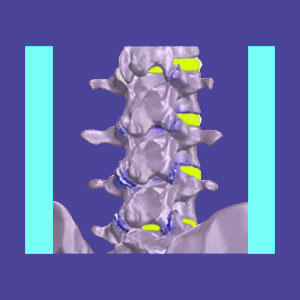
Lumbar facet joint syndrome can create pain through several different methods, including mechanical dysfunction and neurological compression. Facet joint arthritis is commonly found in the lower back, since this is an anatomical location that features universally significant structural degeneration in almost all adults. Let’s start this essay off correctly by clarifying the simple fact that facet joint degeneration and facet joint syndrome are 2 completely different things. Facet degeneration is not inherently painful or pathological in any way, while facet syndrome describes an inherently painful condition related to zygapophyseal joint origin. We will expound on this idea throughout the article to clarify the various diagnostic terms and their significance to patients.
This treatise examines facet joint syndrome in the lower back. We will define the mechanisms that can cause low back pain and also provide some little known truths of facet joint arthrosis. Finally, we will explore the most effective therapies for facet joint pathologies.
Lumbar Facet Joint Syndrome Explained
Facet joints, also called zygapophyseal joints, are spinal structures that connect vertebrae to one another and help regulate and limit spinal movement. As with many other bodily joints, the facet tissues will deteriorate over time and even more so when subjected to particularly aggressive usage. Basically, in people who place more stress on the joints due to work or recreational pastimes, the facet joints will likely demonstrate more degenerative effects earlier in life than in typical human anatomies.
Fact joints are composed of a set of spinal processes that connect to link neighboring bones together. The inferior articular process from the vertebra above links to the superior articular process from the vertebra below. The regions of articular connection are protected by cartilage on the bony surfaces of the joint and are wrapped in a capsule of ligaments filled with synovial fluid. All of these measures help to insure smooth mobility of the joint and a full, painless range of motion, as designed. However, time and activity degenerate the joint tissues, causing the synovial fluid to dry out and the cartilage to wear away from the joint surfaces. This creates more friction in the joint and increases the interactions between skeletal surfaces.
In response, the arthritic processes tend to attack the joint, creating spurring and arthritic debris that can lead to neurological compression or mechanical dysfunction of the joint structure. Some facet syndrome patients might also suffer from ligament-related dysfunction of the structure, causing hyper-laxity or hypomobility.
Lumbar Facet Joint Pain
Most facet joint degeneration is completely or mostly painless and will not create any pathology within the spine. However, facet joint syndrome describes truly symptomatic forms of joint deterioration that involve nerve compression, range of motion problems or mechanical dysfunction. Each of these individual symptomatic profiles is detailed below:
Neurological compression can occur within the facet joint itself, affecting the tiny nerves that innervate the joint structure. Symptoms include sharp, burning and extremely localized pain, most often exacerbated by movement.
Osteophytes can form on the posterior border of the neuroforaminal spaces and might contribute to a pinched nerve root. This symptomatic profile does not qualify to be called facet syndrome, but is still related to facet joint degeneration. Symptoms of this condition are well documented in our coverage of lumbar pinched nerves.
Mechanical pain is generated from mobilizing the joint. Osteophytes and/or arthritic debris might interfere with the joint surfaces moving against one another. Some patients experience painful movement, while others also experience reductions in range of movement when large bone spurs actually become impediments to normal joint mobility.
Ligament problems can involve laxity, creating instability in the joint and possibly in the regional spinal area, or might involve hypomobility conditions that limit joint movement partially or completely. Some hypomobile facet joints freeze completely, creating significant functional restrictions in the affected area of the vertebral column.
Lumbar Facet Joint Syndrome Treatment
Proper indicated treatment for facet joint syndrome is wholly dependent upon the causative mechanism of pain and the particular parameters of the patient’s health and symptomology. There are conservative methods of care that mostly provide symptomatic relief and curative measures of care that mostly involve surgical intervention to resolve the underlying cause of pain.
Patients with minor symptoms and no significant loss of functionality might choose to hold off on surgical approaches to care, instead utilizing drugs, injections, chiropractic and other noninvasive therapies to reduce pain. Patients with some forms of facet syndrome might enjoy complete cures utilizing nonsurgical spinal decompression, although this treatment is not indicated for all forms of facet joint-related pain.
Surgery for facet joint concerns will address the structural problems deemed causative for pain. There are several approaches to care, depending on the patient’s unique case profile. Both ligament and bone-based pathologies can be resolved easily using minimally-invasive surgical techniques in most patients. When the diagnosis of facet syndrome is sound, surgical cures are not only possible: they are likely, although continued degeneration of the lumbar spine might still create new pain problems in the future.
Before seeking any type of lumbar facet syndrome treatment, be sure to first verify the accuracy of the diagnosis by seeking more than one medical opinion and learning all about your many therapy options. We provide a comprehensive picture of facet joint syndrome on our other website Facet-Joint-Pain.Com. If you want to learn everything about facet joint pain, then this site is made just for you.
Lower Back Pain > Arthritis in the Lumbar Spine > Lumbar Facet Joint Syndrome





